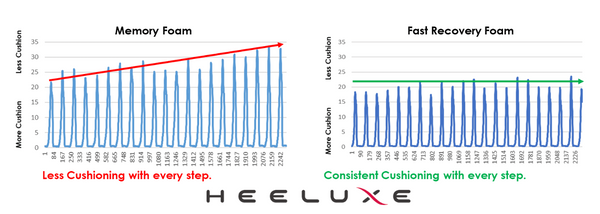Memory Foam Shoes - Are They Really the Best for Your Feet?
Jun 12,2023 | Marketing Sunnystep

Soft, comfortable and energy absorbent, these are the features that describe the material we know as memory foam. Although it sounds perfect for happy feet, research surrounding this high-tech material says otherwise, making us question whether it is suitable for your feet.
In fact, several foot pain, heel pain and back pain complaints have been made by users of memory foam shoes! This includes the possibility of inflamed heel tendons or swollen ankles. Some podiatrists have even noticed this issue and warned the public against wearing memory foam shoes. So what is memory foam? What harm do they cause, and what alternatives are out there?
What is Memory Foam?
Before memory foam made it into your commercial mattresses, pillows and shoes, its invention was funded by NASA for the purpose of protecting and cushioning test pilots during flights. It was created to be more dense and viscous than common types of foam, standing out because it softens through contact with body-heat to morph the contours of your body. As its name suggests, it also retains the ‘memory’ of whatever presses into it by briefly holding the shape of the indentation before slowly rising back to its original shape.
With the description of what memory foam is, it’s easy to assume that footwear made with this material is considered comfortable shoes or to be recommended to people with foot pain or other foot conditions. This statement may be true, due to the way it morphs to your body with very little resistance and prevents pressure from building up in any part of the feet, but sadly, only to an extent.
What Are Some Potential Problems of Memory Foam Shoes?

Source: Heeluxe, 2021
Footwear research company Heeluxe says that memory foam’s slow rising feature may be alright when you want to spend 8 hours lying still on your mattress, but becomes a problem when you’re on the go. In other words, memory foam provides poor support for your feet when walking. Memory foam compresses with each step you take, and it will not get a chance to rise fully before your next step. The cyclical action of adding pressure to the memory foam through walking means that you will end up with a base that provides less cushioning, which means less arch support with every step. This does end up being problematic because shoes with consistent, strong arch support are necessary for keeping your spine neutrally aligned to avoid experiencing symptoms like back or hip pain.
If you have conditions like flat feet or conditions where your feet roll excessively inwards or outwards when stepping on the ground, memory foam insoles can compress excessively on one side and retain ‘bad memory’ of your gait. The problem with this is that it encourages the abnormal gait instead of correcting it, and can cause uneven distribution of pressure through your feet, which can result in issues like plantar fasciitis that makes you experience foot pain or heel pain. In addition to that, some gaits can cause weight to be unevenly distributed to one side of your ankles, making you prone to injuries.
Memory foam is also sensitive to heat and becomes softer with higher temperatures. Which definitely makes it not ideal for users who live in tropical countries if your own increased body temperature could lead the memory foam insoles to lose its arch support by the end of a hike or run! Moreover, memory foam is known to be prone to collapse after a period of wear, where they become unable to rise after being compressed and feel hard to the touch. This can take place in as short as a few weeks to years depending on the quality of the foam and the frequency of wear. The last thing you want is for the wear and tear of this material to add further foot pain or strain to your legs in the midst of an activity where you are already in the state of fatigue.
If not Memory Foam, then What?
Just as there are many unhappy owners of memory foam shoes, some people face minimal issues and swear by it for relieving any discomfort or foot pain. The key could be to adapt them to your own circumstances. Memory foam shoes may be great if you’re looking to take the occasional pain-free stroll, but less suitable for covering long distances or conducting intense activities. Perhaps they're better as walking shoes and not for any vigorous activities, and that’s okay. However, the best thing to wear to avoid any of the issues mentioned above is to find insoles that not only provide arch support, but are also made of durable material that won’t lose its shape, like polyurethane. So maybe when you shop for your next pair of shoes, don’t merely listen to hearsay about how secure a type of material may be, but think about your lifestyle and find the most suitable and comfortable shoes for it!
If you’re a bit confused on where to find good arch support, don’t you worry, we’ve got just the brand for it. As aforementioned, durable materials like polyurethane is recommended for arch support, which is what the local Singaporean brand Sunnystep uses. Other than being long-lasting because of the material, along with having the shape of the arch support not collapsing, they also provide pressure points inspired by Chinese TCM to allow for more relief and comfort while walking, an additional unique feature of arch support insoles you won’t be able to find with lifestyle, minimal and fashionable shoes. So what’s stopping you?. Visit the Sunnystep webstore so you can take a look at new, stylish and comfortable shoes.

